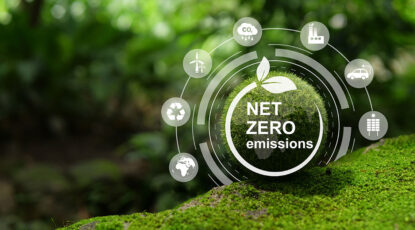We are in unprecedented times. The need for low and zero carbon power has never been greater, the demand more palpable and yet the challenges so great. The remaining carbon budget, the net amount of CO2 that can still be emitted without hitting a particular global warming threshold, is becoming strikingly smaller each passing year.
There is some uncertainty in the carbon budget, based on the associated warming trajectory, but the reality is sobering. The latest analysis in the journal Nature suggests that for a 50% chance of keeping warming at 1.5 degrees Celsius, the carbon budget is approximately 250 GtCO2, equal to approximately six years of current CO2 emissions (source). This new figure is half the size of the estimated carbon budget in 2020 and reinforces the urgency to act.
In last year’s Sustainability Report, we devoted time to address the importance of the concept of the Time Value of Carbon, which places a premium on near-term climate action considering the uncertainty and risk associated with the pace and extent of climate action. Bloom has long been an advocate of pragmatic, near-term emission reductions, which is why we provide avoided emissions modeling in our annual sustainability report. This latest analysis tells us there has never been a more important time to act quickly, decisively, and at scale to achieve emissions reductions wherever possible, but particularly in the energy sector, which contributes three quarters of global carbon emissions (source).
The world is rightfully focused on a long-term shift to renewable solutions, but there are very significant barriers to the speedy transformation of the system that are misaligned with the realities of our remaining carbon budget. We are struggling to interconnect new projects, build the high voltage transmission capacity needed to move renewable power to load centers and integrate firm baseload power solutions generally. Our policy preferences seem to suggest that we have until 2045 or 2050 to make the necessary changes. The reality is that we now have until 2030…maybe. In order to extend our time horizon and ration our remaining carbon budget to buy the energy sector and the world time for systemic evolution, we need to find emission reductions, and we need to find them now.
So, this Earth Day, we are releasing our fourth sustainability report highlighting ongoing efforts to drive near-term impact, transform the energy sector, and evolve our company in response to this historic moment. The report outlines our strategic approach, highlights our ongoing product innovation, details our social and environmental impact and breaks down how our company is evolving for scale. Three important topics covered in the report are linked to broader themes in the industry and policy environment: avoided emissions, climate risk and a just transition.
Avoided Emissions
Each Energy Server deployment displaces power supplied to our customers from an alternative source, typically centralized power grids. Each year, we calculate the avoided emissions from our projects using project-based approaches outlined in the Greenhouse Gas (GHG) Protocol (source). This year our net emissions were -992,481 tonnes of CO2e from our projects with another 120,000 tonnes avoided from our certified gas program.
With the creation of lifecycle accounting requirements from the federal government to facilitate distribution of project support from the Inflation Reduction Act (IRA), acceleration of 24/7 carbon free energy goals, the GHG Protocol is poised to evaluate the addition of an avoided emissions accounting framework within its Scope 2 guidance revision. This is something we at Bloom wholeheartedly support. Learn more about our approach to this important topic here.
Climate Risk
A new addition to our 2023 report is our first forward scenario analysis focused on quantifying inherent physical climate risks and our exposure to carbon pricing across a sample of our facilities, projects, and supply chain.
We used the Shared Socioeconomic Pathways scenarios released along with the Intergovernmental Panel on Climate Change’s sixth assessment report published in 2021 to inform the analysis. Our results demonstrate the magnitude of potential impact across each scenario and time horizon, providing insight into the extent of risks posed at the different locations as well as the change from historic data. Our assessments target 2030 and 2050 milestones at 13 Bloom business locations in the U.S. and internationally.
As we look ahead, there are new regulatory requirements affecting Bloom and all other large companies in the U.S. Both the state of California and the Securities and Exchange Commission have mandated more comprehensive reporting requirements in the last few months. Both regulatory disclosure programs are focused on climate related risk reduction and our efforts to deepen our climate risk reporting are designed to get ahead of these requirements and advance our understanding of how and when climate related risks will impact our business.
Just Transition
Finally, Bloom is working to develop partnerships in the various communities in which it operates. These are relationships we hope will help drive ideal outcomes for workers, community members, businesses, and local governments that have been impacted negatively by the combustion of fossil fuels.
We celebrated our 10th anniversary at our Delaware assembly facility. In that time, our local workforce has grown to nearly 800 from 1, revolutionizing a legacy automotive facility into a facility driving the clean energy economy. Our employees successfully delivered our 15,000th Energy Server™, the solid oxide fuel cell equipment that has been the centerpiece of our commitment to making clean, reliable electricity affordable to all. We spent 2023 talking about the work being done in Delaware and the colleagues who make it happen and we go further in this year’s sustainability report.
We have also expanded our production capacity at our Fremont, Ca., manufacturing facility and are very pleased to report that our application for a Qualifying Advanced Energy Project Credit Allocation under Internal Revenue Code Section 48C(e) for Fremont was granted at $75,300,000.
We appreciate the opportunity to highlight the important work we do each year as we grow our company into a leader in the energy transition. Thank you for your interest and engagement.



